Canon XA65 review: great pro camcorder let down by its AF
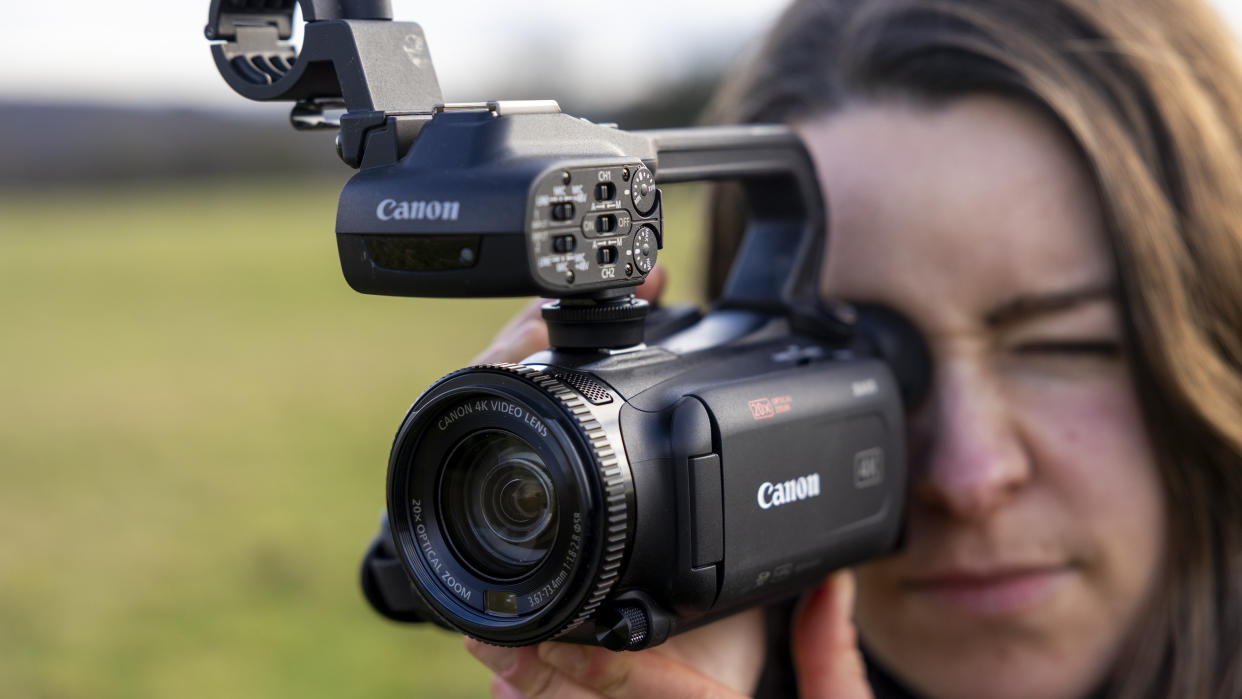
If there's one thing I've learned while testing and reviewing the Canon XA65, it's that the acronym ENG stands for electronic news gathering. The XA65 is an ideal ENG video camera, given that it's capable of being operational seconds after being switched on. And that its epic 20x optical zoom range (29.3 – 601mm on a 35mm equivalent) and 40x digital zoom is enough to capture breaking moments up close and far away almost instantly.
Camcorders have a somewhat unfair reputation for being dated, clunky, and old-fashioned. And in many ways, the Canon XA65 is less sexy than some of the best mirrorless camera and the best cinema cameras. But if you're someone who gets paid to make news or journalism-style content, or you're a documentary filmmaker in search of something capable but compact to shoot video but not stills, the XA65 might be enough for your needs.
Canon XA65: Specifications
Max resolution: 3840 x 2160 px
Sensor: 1/2.3-type CMOS
Total pixels: 21.14MP
Zoom: 20x optical
Memory type: 2 x SD/SDHC/SDXC cards
Dimensions: 109 x 84 x 182 mm
Weight: 750g
The Canon XA65 was released in September 2022 at the same time as three similar-looking pro camcorders; the XA75, XA70, and XA60, plus the prosumer HF G70. At around $2,299/£2,000, it's the company's middle offering in this lineup, with professional functions and quality but a price tag one-fifth lower than the top XA75. Like the XA75 though, the XA65 comes with a detachable handle unit, which allows the camcorder to be carried from the top – for low-level angles you might not reach otherwise – and provides two terminals for the best XLR microphones.
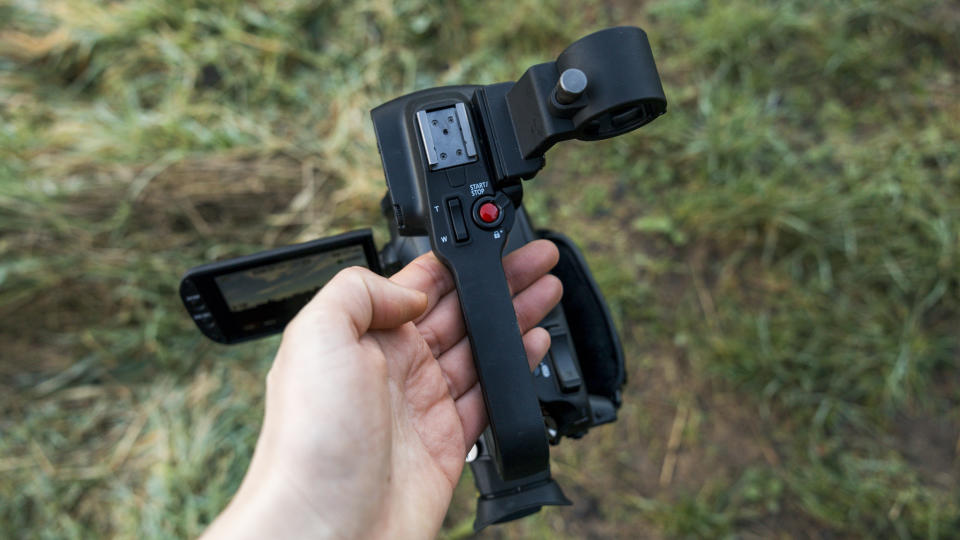
In terms of video recording, you get internal UHD 4K capture in MP4 or XF-AVC file formats; the latter is exclusive to Canon and gives you the benefit of metadata and a higher bit rate, while MP4 is pretty much universal and provides smaller files. External recording via the HDMI or 3G-SDI supports streaming at 1080p and 60fps. I can't get excited by these specs, but they're reasonable at this price point.
Canon has thought about its audience when designing the XA65. The 1/2.3-inch CMOS sensor is smaller than the Canon XA75's 1-inch sensor, keeping the cost down, but the 20x optical is incredibly versatile, focusing as close as 1 cm at the widest end to 60 cm across the whole zooming range. It's a real do-it-all camcorder, allowing jobbing filmmakers to pick it up and start shooting within minutes, arguably without a steep learning curve. Once you buy a camcorder like the XA65, you only need a professional mic and a few of the best video lights and you're ready to start rolling. But is it too limiting?
Canon XA65: What's changed?
The Canon XA65 replaces the Canon XA45 which appeared after a delayed release in 2021. It sits under the Canon XA75 and above the Canon HF G70 which were both announced at the same time.
Compared to the XA45, the XA65 has the same detachable handle with two XLR connectors for adding external microphones, 20x optical zoom, and a 1/2.3-inch CMOS sensor. What's new is the option to record fast and slow-motion video, two convenient USB-C ports for power input and video output, a larger 3.5-inch LCD touchscreen, and a higher-resolution viewfinder. You also get a built-in ND filter for making exposure adjustments in bright conditions.
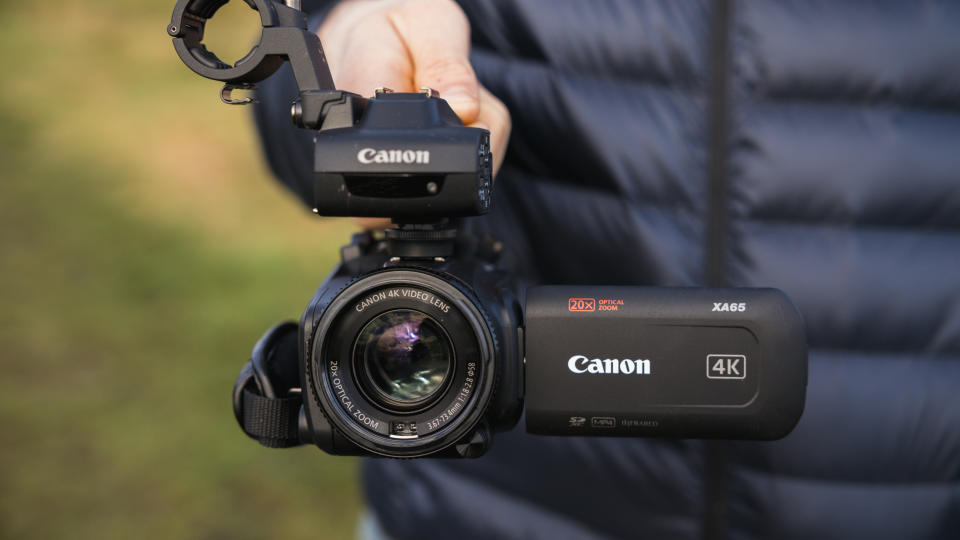
Canon XA65: Design & Handling
When I took the Canon XA65 out of its case, I was struck by how closely it resembles the Canon HF G70 camcorder. The dimensions are almost identical, as is the weight, which makes me feel that Canon has chosen to share the outside design (apart from adding an SDI port) and many of the specs. That said, the major difference is that comes with a detachable handle unit – which the HF G70 doesn't have – a power adapter, a lens hood with a barrier, a mic holder, and a battery pack. The handle mounts securely to the hot shoe and two separate screws at its rear to ensure a sturdy fit. You get quicker at getting it on and off with practice.
The chunky battery slots underneath the viewfinder securely, leaving plenty of room on the base to add a tripod mounting plate. To the right, there's a raised and red oblong-shaped record button, and right again is the menu button, plus a four-way pad and a set button to choose settings. On the left, you find two of five assignable buttons for adding custom settings, plus a zoom/focus switch for the lens ring.
The tactile zoom rocker and focus switch modes sit together on the top right, while the top left is the switch between camera, media (playback), and off. There are two bonus assignable buttons on the left of the LCD, set to AF/MF and pre-record by default. There's also an assignable button – that gives you quick access to a range of options like Menu, and WB Priority – displayed in the bottom left when information is switched on.
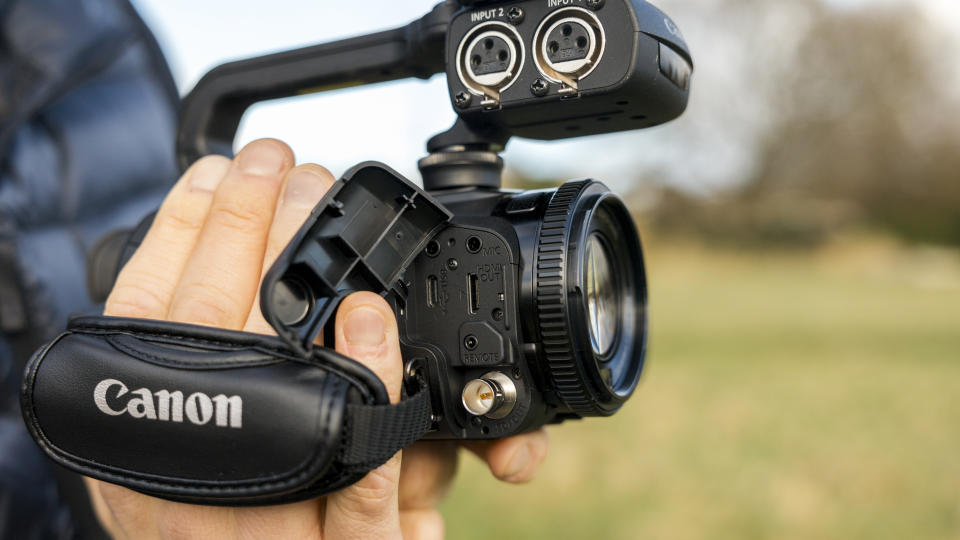
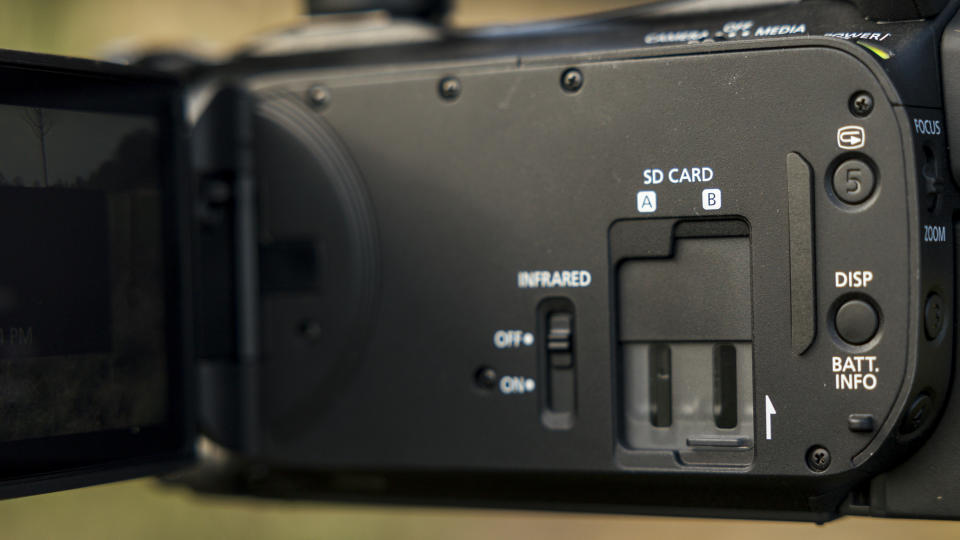
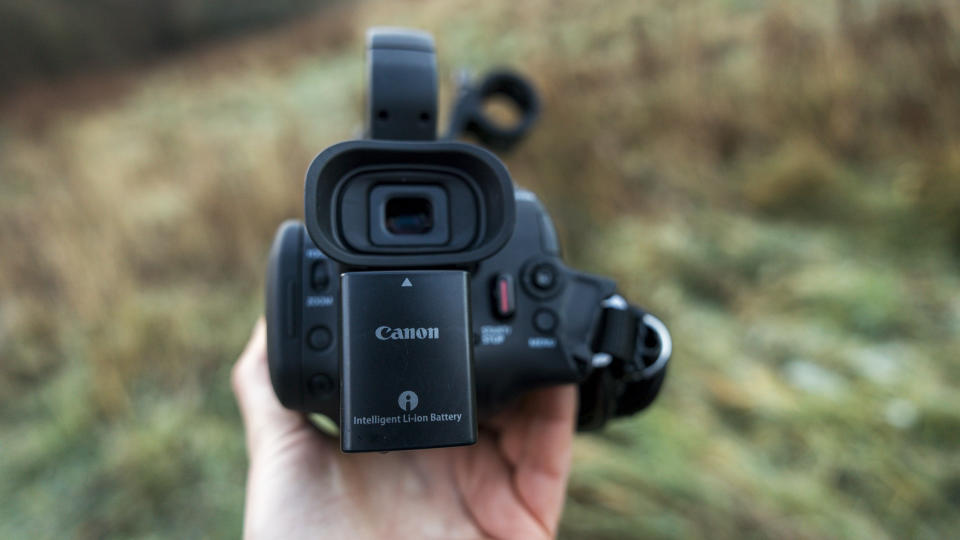
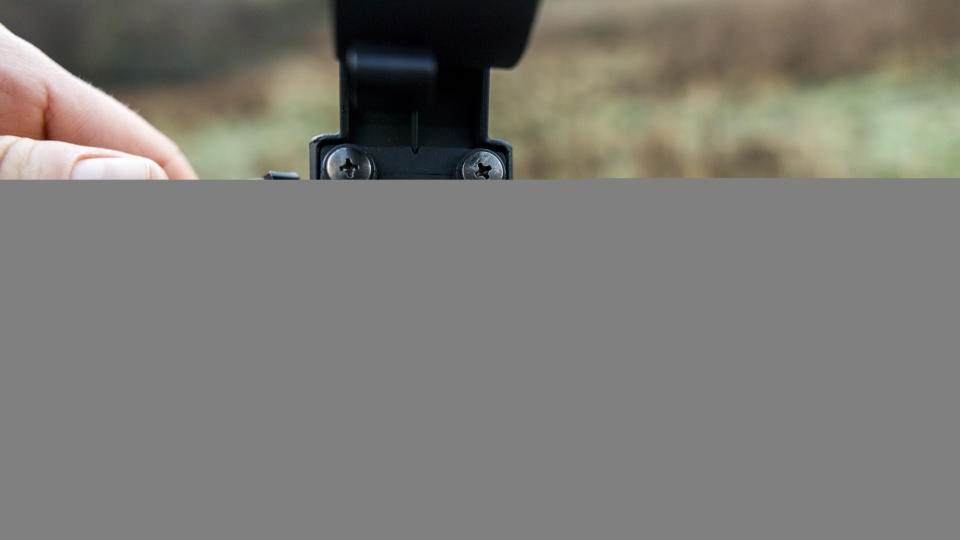
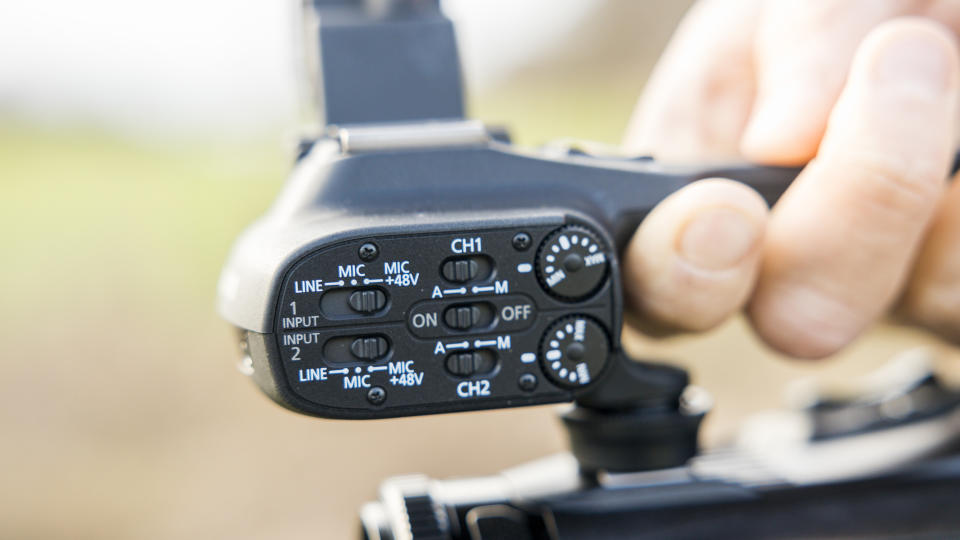
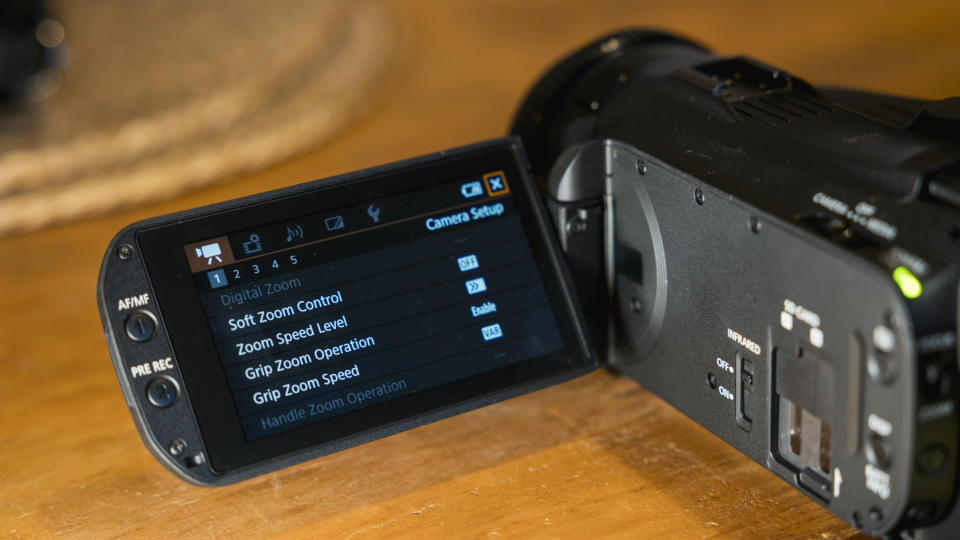
Being familiar with Canon products, I found the XA65 easy to use almost immediately. And I think that's the point. The menu is split up into five Setup sections; Camera, Recording, Audio, Display, and System, which are a doddle to navigate on the touchscreen. You always get fewer physical controls on a camcorder than on an advanced mirrorless model, but what's included on the XA75 is still quite basic. Compared to the Panasonic HC-X2000, you don't get a dedicated switch for setting the ND filter or the Gain. Pros are more likely to fine-tune parameters themselves rather than rely on automated settings, and while the assignable buttons do help with quick access, the experience still isn't as smooth.
What is smooth is the focusing mechanism. You can use the rocker, or the lens ring (which can also be set to fine-tune focus). As with all modern cameras, you can compose the frame, view settings, and keep an eye on levels in two ways; with the LCD monitor or the viewfinder – but not at the same time. The capacious 3.5-inch (diagonally) touchscreen is wider than EOS R cameras to reflect the proportions of video footage, and I found the 2.76 million dot resolution made it a joy to use. At the brightest setting, I was still able to view the screen in bright sunshine. The screen can be rotated 180 degrees to face you for pieces to the camera and tucked back in when you want to use the viewfinder or stop filming.
The electronic viewfinder is just as crisp and colorful. It requires pulling out to activate and can be tilted up like a periscope to help you look through at a more natural angle. If you're planning to shoot with the XA65 handheld, it's a good idea to adjust the velcro strap on the strap so that your hand has the tightest fit possible against the camera body. It took me a day or two to notice this, but once I'd secured everything, I got far less jogging in footage.
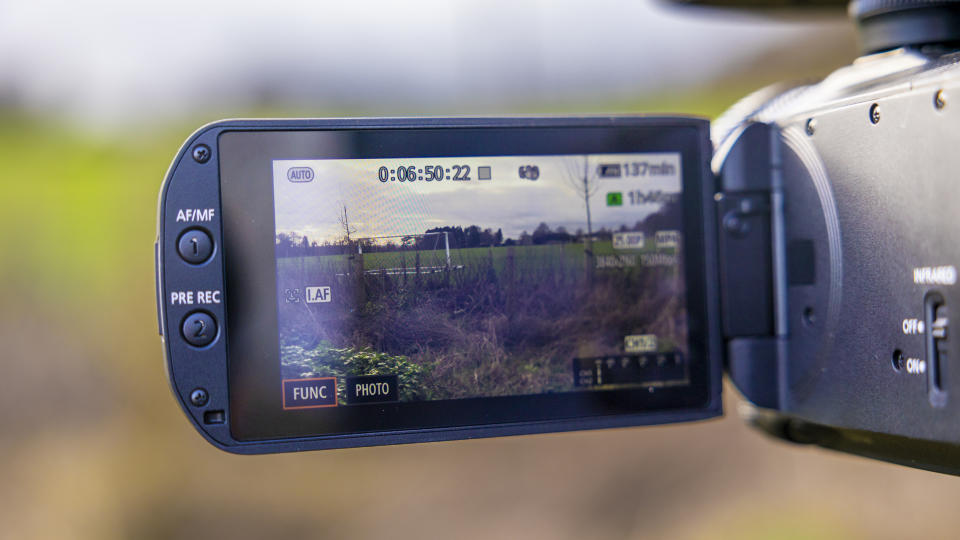
Canon XA65: Performance
I was disappointed at the quality of raw (unedited) footage from the XA65, simply because it's similar to the HF G70 at half the price, and noticeably worse than the XA75 which is just a few hundred $/£'s more. The XA65 is prone to lens flare without the hood attached, which happens to be a look I love – but it won't please everyone. Shooting toward the sun through a forest brought noticeable light leaks, and the camcorder struggled to expose the scene correctly on its own, underexposing by a few stops to compensate.
Many users are likely to be on a tripod or gimbal for professional applications, only relying on the XA65's 5-axis image stabilization occasionally. It can be set to three strengths – Dynamic, Standard, and Powered, and I found that Dynamic was vital for steady handheld walking shots. It did a good job at the wide end of the zoom but felt super shaky when I was recording birds at the full 20x zoom, however.
The second issue is motion blur when filming in 4K since you're limited to 25p. We take for granted the speeds that the latest cameras can record in, and if you're used to 50 or even 60p, you'll be frustrated by the XA65's 4K for sports, or people and animals darting around. Shooting in 1080/50p is an option if you're happy to downgrade the resolution. Speaking of speed, I used the Slow & Fast Motion menus to record footage up to x1200. These are a fun gimmick, slowing or speeding up the frame rate of a clip (with x2 Fast motion, a 2-minute shooting time becomes a 1-minute clip), but they don't replace more progressive frames in real-time.
As I've mentioned, the option to shoot in an MP4 or XF-AVC file format adds versatility and XML data associated with the clip. I compared both, but couldn't find enough difference visually to record in XF-AVC. With the XA65 you don't get Canon Log for color grading, but the Automatic White balance was accurate throughout my testing, and setting it manually between 2,000–15,000K means you can match another camera or lighting setup.
Unlike the XA75, the XA65 has hybrid autofocus instead of Canon's more advanced Dual Pixel CMOS. Put simply, the tracking and speed were fine, but nowhere near as impressive as my Canon EOS R6 or EOS R5 for detecting subjects or keeping them sharp. Tapping on the LCD monitor is a quick way to bring faces into focus, but it's not easy to do with your left hand without jogging the footage. And I found it impossible to keep up with animal movements or children at a family party. The camcorder performs much better on a tripod, with a fixed zoom and focus set manually – the kind of setup you'd have for a stage at an event.
What was impressive was the minimum 1cm focusing distance at the widest end of the zoom, which let me shoot to almost macro – ideal for wedding videographers wanting detailed shots of rings, flowers, and decorations, for example. The zoom rocker on the body and handle offered subtle transitions, but I largely used the tactile lens ring to fine-tune the focus.
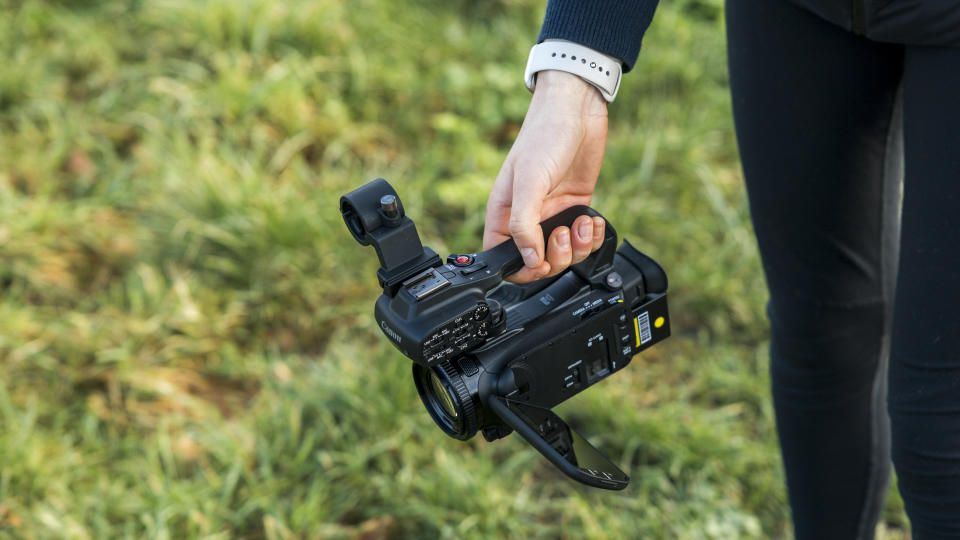
Professional audio recording is a big draw of the XA65, given it can be recorded internally using the 3.5mm port on the body or an XLR port on the handle (in 16-bit MPEG-2 AAC-LC or LPCM). Adding an Audio-Technica AT875R condenser mic to an XLR port allowed better audio instantly, and checking the level meter on the screen and tweaking the independent level control is helpful. However, I mostly used the in-built mic for on-the-go situations and found it was able to pick up voices as well as ambient sound like birdsong even in light wind.
The XA65 is designed to run and run, so there are no limits on recording time due to overheating. Your limit is the included BP-820 battery, which Canon quotes at a typical 95 minutes of juice at full video resolution (140 minutes with the bigger BP-828 sold separately). I recorded clips intermittently on a two-hour walk at UHD/25p (using just the built-in mic), and the camcorder died just before the end. I have no issues with the battery life given that most professionals will carry plenty of spares. And I like that you can simultaneously power/charge the camcorder via one USB-C and transfer files using a second.
The XA65 is a compact camcorder, even with the handle attached. You can fit it in most small messenger bags if you're a solo shooter, and it could become a transportable part of a much larger pro setup. As always, I feel very noticeable recording in public with a camcorder, but for a news professional, that's likely par for the course. My main concern with the XA65's design is the lack of weather resistance. Canon doesn't give the camcorder an official rating, and the ports on the body are very exposed when you open up the rubber flaps to plug in cables. The battery too, is on full show at all times, and in damp, foggy weather I'd be wary of moisture damage.
Canon XA65: Sample video
The footage in these clips comes from a week of walks in a cold, UK winter. It was recorded MP4 at 4K UHD 25P, using the camera's built-in microphone, or the Audio-Technica AT875R condenser mic where labelled on the clip.
Canon XA65: Final Verdict
The Canon XA65 is a good choice for paid professionals who need a good-quality video camera but don't want to change lenses or tweak exposure settings too heavily. If you want the extra audio controls and XLR microphone inputs that its detachable handle affords, it's worth the upgrade from the prosumer HF G70.
The lack of connectivity from either Bluetooth or Wi-Fi takes away from the XA65's versatility, although being able to stream live events via UVC is always an option. Its design and layout are sensible but unexciting, and I'd like to see some waterproofing at this point before using it in anything but fair weather outdoors. Hybrid Canon cameras like the Canon EOS R6 Mark II will offer you better video quality and autofocus in a myriad of different filming formats. And they function well as still cameras, which the XA65 certainly isn't.
The Canon XA65 is a neat camcorder for around the $2,299/£2,000 mark, and it represents better value given you don't have to pay extra for lenses. I'd recommend it to videographers who are creating quick, news-friendly content or documentaries rather than cinematic visuals to wow audiences or clients. Despite at first feeling like an outdated concept, I enjoyed the handling and simplicity of the XA65 enormously. It'll have niche appeal in a diminishing market, but if you're a professional who still believes in the form factor of a camcorder and doesn't need a larger sensor, the XA65 should serve you well.
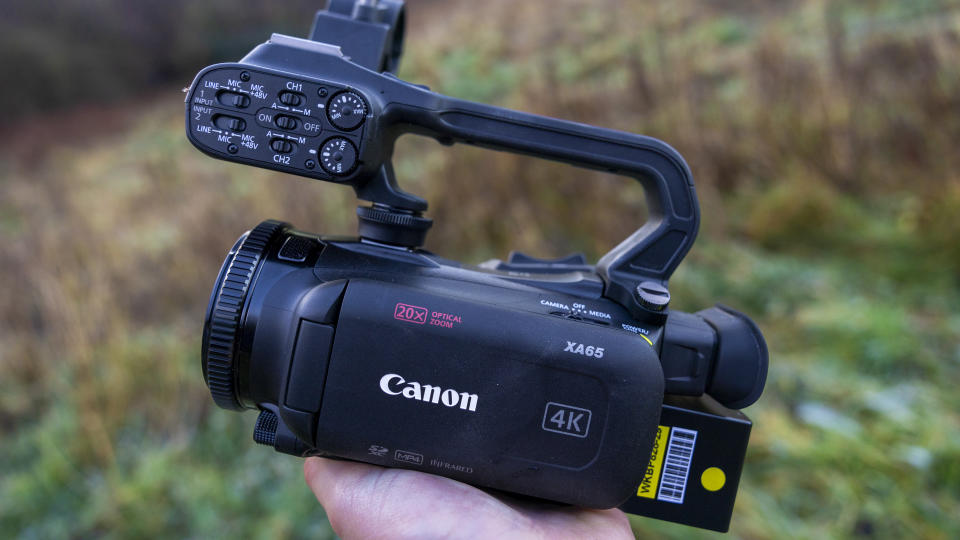
Should you buy the Canon XA65?
✅ Buy this if...
You like the camcorder format
You want a versatile zoom lens
You want XLR audio inputs
🚫 Don't buy this if...
You need high-res stills
You're a social-first creator
You want interchangeable lenses
Alternatives

The Canon HF G70 is a cheaper camcorder aimed at prosumers rather than pros, but its specs and handling match the XA65 in many respects. You still get a 3.5-inch touchscreen LCD and a 20x optical zoom, but no XLR terminals for high-quality audio or a detachable handle that also offers greater control.

If you need a mirrorless camera for shooting stills just as well as video, the Panasonic Lumix S5II is a top hybrid option. It's similarly priced (body-only) to the XA65, and you get unlimited 4K/60p 4:2:2 10-bit recording internally, plus a larger 24.2MP full-frame sensor.

